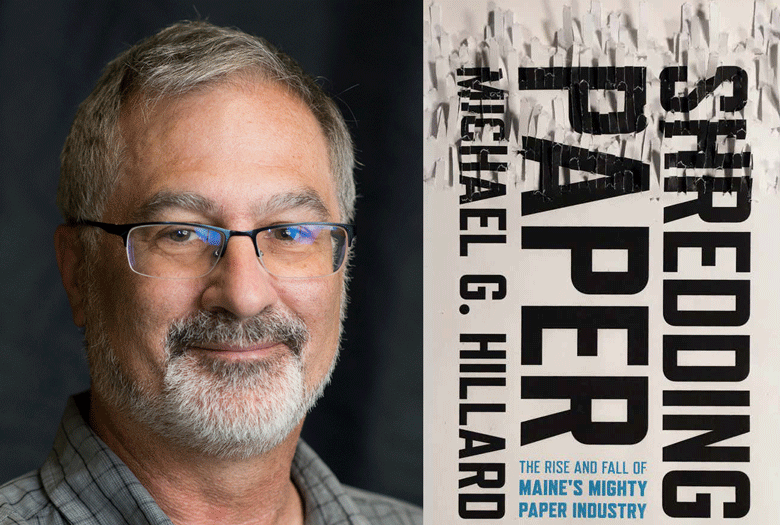Shredding Paper: The Rise and Fall of Maine’s Mighty Paper Industry
By Michael G. Hillard
Understanding Maine’s once-gigantic paper industry and what happened to it is a matter of perspective. Michael Hillard, author of Shredding Paper, a well-researched look at the mills that once employed thousands in communities all over Maine, looks at paper manufacturing from an economic and social point of view—why it made sense to build mills here in the first place, and how many of these companies stayed in business by engaging in a form of social engineering.
 Papermaking didn’t make sense in Maine in its early days, when a mill’s feedstock consisted of waste rags and the best place for a mill was near some big-city source—hence the early development of paper mills near Philadelphia in the 18th century. Everything changed, Hillard points out, with the development of mechanical (groundwood) and chemical (sulfite) processes to produce wood pulp from trees. These technologies were developed in the mid-19th century, and by 1900 new paper mills were sprouting all over heavily-forested Maine.
Papermaking didn’t make sense in Maine in its early days, when a mill’s feedstock consisted of waste rags and the best place for a mill was near some big-city source—hence the early development of paper mills near Philadelphia in the 18th century. Everything changed, Hillard points out, with the development of mechanical (groundwood) and chemical (sulfite) processes to produce wood pulp from trees. These technologies were developed in the mid-19th century, and by 1900 new paper mills were sprouting all over heavily-forested Maine.
Turning logs into paper is an operation that—a few generations ago at least—had a lot of moving parts. There was harvesting labor, meaning an army of woodcutters working under frozen conditions to cut thousands of trees. There was the need to get all of the resulting logs to mills, meaning (before trucks and roads) floating them down rivers. There was the need for electricity sufficient to run grinders, digesters, and paper machines in the mills, requiring hydroelectric power generation systems on a massive scale. And there’s the need for a labor force in the mills to run things.
Hillard focuses mostly on labor’s part of this system, and does so more than competently. Perspective, however, requires me to focus somewhat differently, and to note that the story he tells isn’t as complete as it might be.
They had relied on cheap electricity … and expanded over the years into what by 1980 had become the world’s largest private hydroelectric system.
In the 1980s, as the environmental reporter for the Bangor Daily News, I spent several years covering Great Northern Paper’s effort to license its proposed Big A dam on the West Branch of the Penobscot River. Papermaking in Maine was often a tradition-bound business, as Hillard makes clear, and for Great Northern, building yet another dam on the Penobscot was part of the tradition. But at Big Ambejackmockamus Falls—Big A—it didn’t happen. The story’s not in Hillard’s book so I’ll tell it here.
Since the Millinocket and East Millinocket mills went on line around 1900, they had relied on cheap electricity generated by a network of dams and generators and expanded over the years into what by 1980 had become the world’s largest private hydroelectric system. All computer controlled by the 1970s, it had kept the mills humming at a predictable cost. To Great Northern engineers and their corporate bosses seeing a need for more electricity in a growing paper market, the solution was simple: build another dam.
But the world had changed by the 1980s. Great Northern was no longer the only user of the river. The end of log-driving had opened up its waters, newly clean thanks to the Clean Water Act, to fishermen and whitewater rafters, to whom the idea of yet another dam and impoundment—even at what everyone agreed was a great site for the purpose—was a very bad idea. Opponents pointed out, correctly, that Great Northern had done too little to make its mills more energy-efficient.
After threatening major job cuts and using its political connections, Great Northern got most of the permits it needed, but the cost had become too big and the project was eventually abandoned. In the end the company sold its mills to one or more buyers, its dams to another. By 2014 both mills had closed.
But back to Hillard’s book.
The same thing, minus the Big A part of the story, happened to mills and mill towns all over Maine. Some mills failed because their owners hadn’t modernized; many suffered from foreign competition. China, to cite one example, poured billions into its paper and printing industries while underselling competitors in the West, including Maine.
Environmental factors including spruce budworm (brought on to some extent by forest practices) required huge investments by landowners and the state to control it. Forest fires in older, even-aged stands of timber were another costly problem.
Finally, the companies’ investments in timberland (Great Northern owned two million acres at one time), not to mention the 10,000 miles of roads companies were obliged to build to replace the rivers to transport logs, got harder to explain to profit-hungry managers and shareholders.
An era—a way of life created by a single Maine industry over a century—came to an end.
With or without its biggest hydro project, however, Great Northern was among a number of companies practicing a form of capitalism that seems out of fashion these days: building housing and whole towns for their workers, paying wages high by comparison with other Maine jobs, giving or leasing camp lots to its workers on the lakes created behind their dams, building schools, keeping communities stable over the generations.
As Hillard points out, much of this benevolence faded as competition and Wall Street’s demands for profits forced the sale of once family-owned companies to outsiders.
Today, Maine’s paper industry is a shadow of its former self for all of the reasons Hillard (and I) suggest, plus dramatic and obvious changes in markets. The once-seemingly insatiable demand for newsprint has diminished; vast amounts of paper once used in offices has been replaced as systems have gone online. We may not have yet reached the paperless point, but it’s not far away. Most of the magazines that once stacked up on my coffee table have gone digital.
These days, when I want to start a fire in the woodstove, I have to search for something that will ignite. In Maine, a state where papermaking was once a way of life, that’s remarkable.
David D. Platt is former editor of The Working Waterfront.





